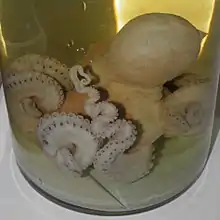Octopus conispadiceus
Octopus conispadiceus (commonly the chestnut octopus[1]) is a species of long-ligula[2] octopus,[3] provisionally placed in the genus Octopus.[4] It was first described by Madoka Sasaki in 1917[5] based on specimens bought at a fish market in Sapporo, Japan.[6]
| Octopus conispadiceus | |
|---|---|
 | |
| Scientific classification | |
| Domain: | Eukaryota |
| Kingdom: | Animalia |
| Phylum: | Mollusca |
| Class: | Cephalopoda |
| Order: | Octopoda |
| Family: | Octopodidae |
| Genus: | Octopus |
| Species: | O. conispadiceus |
| Binomial name | |
| Octopus conispadiceus Sasaki, 1917 | |
Description
O. conispadiceus is large,[5] with a mantle length of up to 210 millimeters and a total length of at least 120 centimeters; its arms are moderate in length, around three times the length of the mantle.[3] There are 140 to 150 suckers on each arm in males and 170 to 190 in females, and suckers are larger in males than females. O. conispadiceus is firm and muscular,[5] with smooth skin,[3] and light gray-blue in color[5] with a white line across its head. It has seven rows of teeth and an ink sac.[3] O. conispadiceus has small eyes.[7]
Distribution
O. conispadiceus is found in cold temperate waters[8] off northern Japan[5] and the Kuril Islands.[3][9] It is a benthic shelf species, living from depths of around 50 to 100 meters,[3] mostly in sandy or muddy substrates.[9]
Life cycle
O. conispadiceus reaches maturity quickly,[9] around 10 to 11 months in cold waters.[10] Juveniles look much like adults, but have a different skin texture.[7] The species has a short life span, with estimates between under two years[9] and three to four years.[3] Females lay from 400[11] up to 1,200 eggs at a time;[3] the eggs are very large,[11] up to 28 millimeters.[5] The size of the eggs suggests that hatchlings are benthic.[3][11]
Use by humans
O. conispadiceus is fished commercially in Japan.[12][3] It is the second most common species of octopus in fish markets in Hokkaido,[9] and is sometimes bycatch in gillnet fishing, especially in Russia[13][14]
References
- "Order No. 229 of the Ministry of Agriculture establishing fisheries restrictions related to some species of aquatic biological resources for the period of 2018". UNEP Law and Environment Assistance Platform. UN Environment Program. 2018-06-04. Retrieved 2023-01-20.
- Rigby, Patricia Robin (2004-01-09). Ecology of immature octopus Enteroctopus dofleini: Growth, movement and behaviour. OCLC 1225501710.
- Norman, M. D.; Finn, J. K. (2016). "Family Octopodidae". In Jereb, Patrizia; Roper, Clyde F. E.; Norman, Mark D.; Finn, Julian K. (eds.). Cephalopods of the World: An Annotated and Illustrated Catalogue of Cephalopod Species Known to Date. Vol. 3. Octopods and Vampire Squids. Rome, Italy: Food and Agriculture Organization of the United Nations. ISBN 978-92-5-107989-8.
- Norman, M. D.; Nabhitabhata, J.; Lu, C. C. (2016-06-29). "An updated checklist of the cephalopods of the South China Sea". Raffles Bulletin of Zoology (Supplement 34): 566–92.
- Voss, Nancy A.; Vecchione, Michael; Toll, Ronald B.; Sweeney, Michael J., eds. (1998). "Systematics and Biogeography of Cephalopods: Volume II". Smithsonian Contributions to Zoology (586): 277–599. doi:10.5479/si.00810282.586.277. ISSN 0081-0282.
- Sasaki, Madoka (1915-07-27). "Notes on Cephalopoda". Annotationes Zoologicae Japonenses. 9 (1): 361–7 – via Biodiversity Heritage Library.
- Sasaki, Madoka (1929-01-31). "A Monograph of the Dibranchiate Cephalopods of the Japanese and Adjacent Waters". Journal of the Faculty of Agriculture, Hokkaido Imperial University. 20 (Supplement): 1–397.
- Gleadall, Ian G. (2004). "Some Old and New Genera of Octopus". Interdisciplinary Information Sciences. 10 (2): 99–112. doi:10.4036/iis.2004.99. ISSN 1347-6157.
- Ma, Yuanyuan; Zheng, Xiaodong; Cheng, Rubin; Li, Qi (2014-06-27). "The complete mitochondrial genome of Octopus conispadiceus (Sasaki, 1917) (Cephalopoda: Octopodidae)". Mitochondrial DNA. 27 (2): 1058–1059. doi:10.3109/19401736.2014.928866. ISSN 1940-1736. PMID 24971549. S2CID 39849240.
- Boletzky, S. V. (1994). "Embryonic development of cephalopods at low temperatures". Antarctic Science. 6 (2): 139–142. doi:10.1017/s0954102094000210. ISSN 0954-1020. S2CID 84124491.
- Sweeney, Michael J.; Roper, Clyde F. E.; Mangold, Katharina M.; Clark, Malcolm R.; Boletzky, Sigurd V. (1992-02-10). ""Larval" and juvenile cephalopods: a manual for their identification". Smithsonian Contributions to Zoology (513): 1–182. doi:10.5479/si.00810282.513. ISSN 0081-0282.
- Kubodera, Tsunemi (2009). "A Review of the Deep-sea Cephalopod Fauna off the Pacific Coast of Northeastern Japan". In Fujita, T. (ed.). Deep-sea Fauna and Pollutants off Pacific Coast of Northern Japan (PDF). Tokyo, Japan: National Museum of Nature and Science Monographs. pp. 385–404.
- Maeda, Saki; Sakurai, Kenji; Akamatsu, Tomonari; Matsuda, Ayaka; Yamamura, Orio; Kobayashi, Mari; Matsuishi, Takashi Fritz (2021-02-11). "Foraging activity of harbour porpoises around a bottom-gillnet in a coastal fishing ground, under the risk of bycatch". PLoS ONE. 16 (2): e0246838. doi:10.1371/journal.pone.0246838. ISSN 1932-6203. PMC 7877735. PMID 33571306.
- Besednova, N. N.; Zaporozhets, T. S.; Kovalev, N. N.; Makarenkova, I. D.; Yakovlev, Yu. M. (2017-03-01). "Cephalopods: The potential for their use in medicine". Russian Journal of Marine Biology. 43 (2): 101–110. doi:10.1134/S1063074017020031. ISSN 1608-3377. S2CID 255014727.